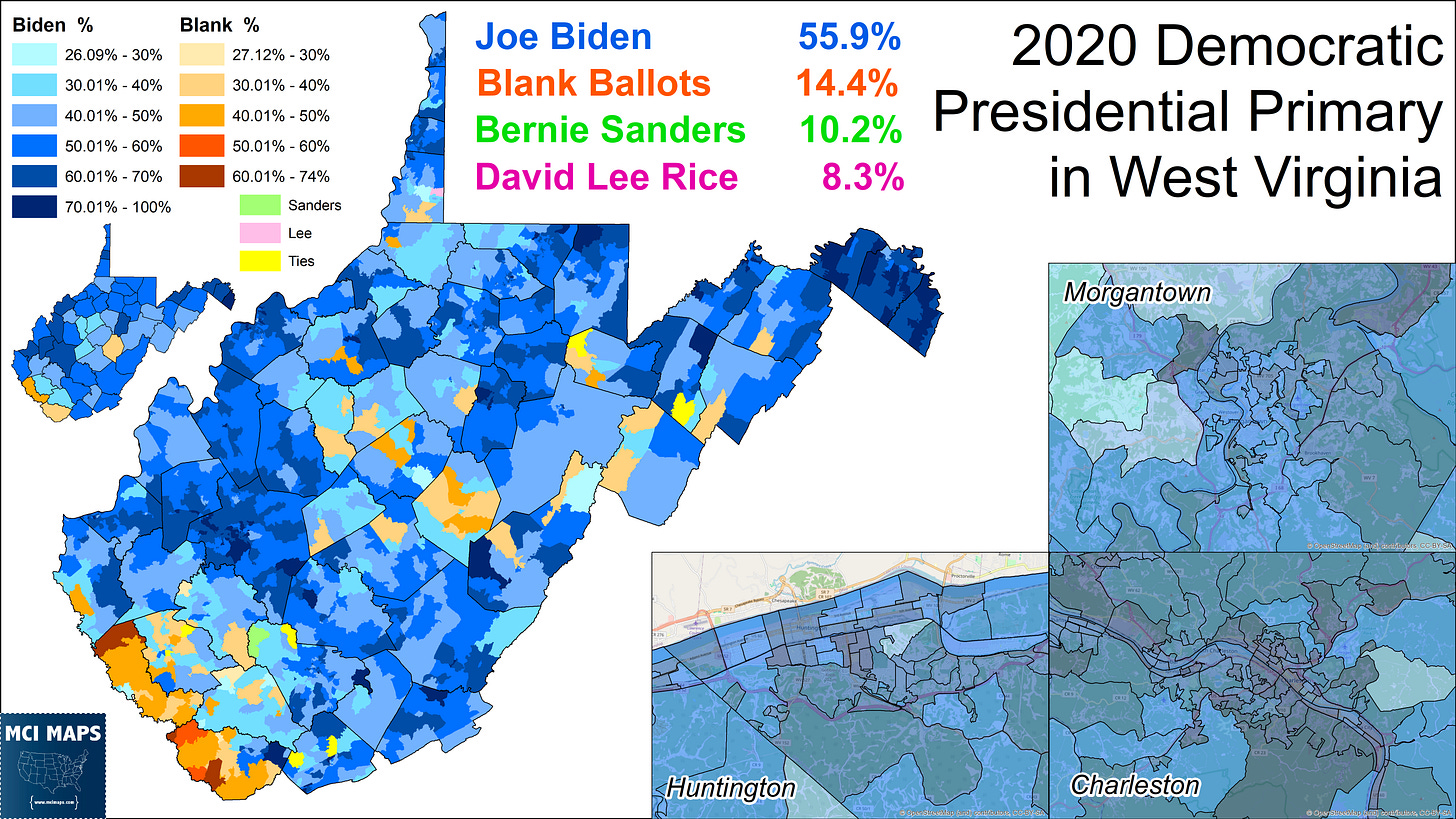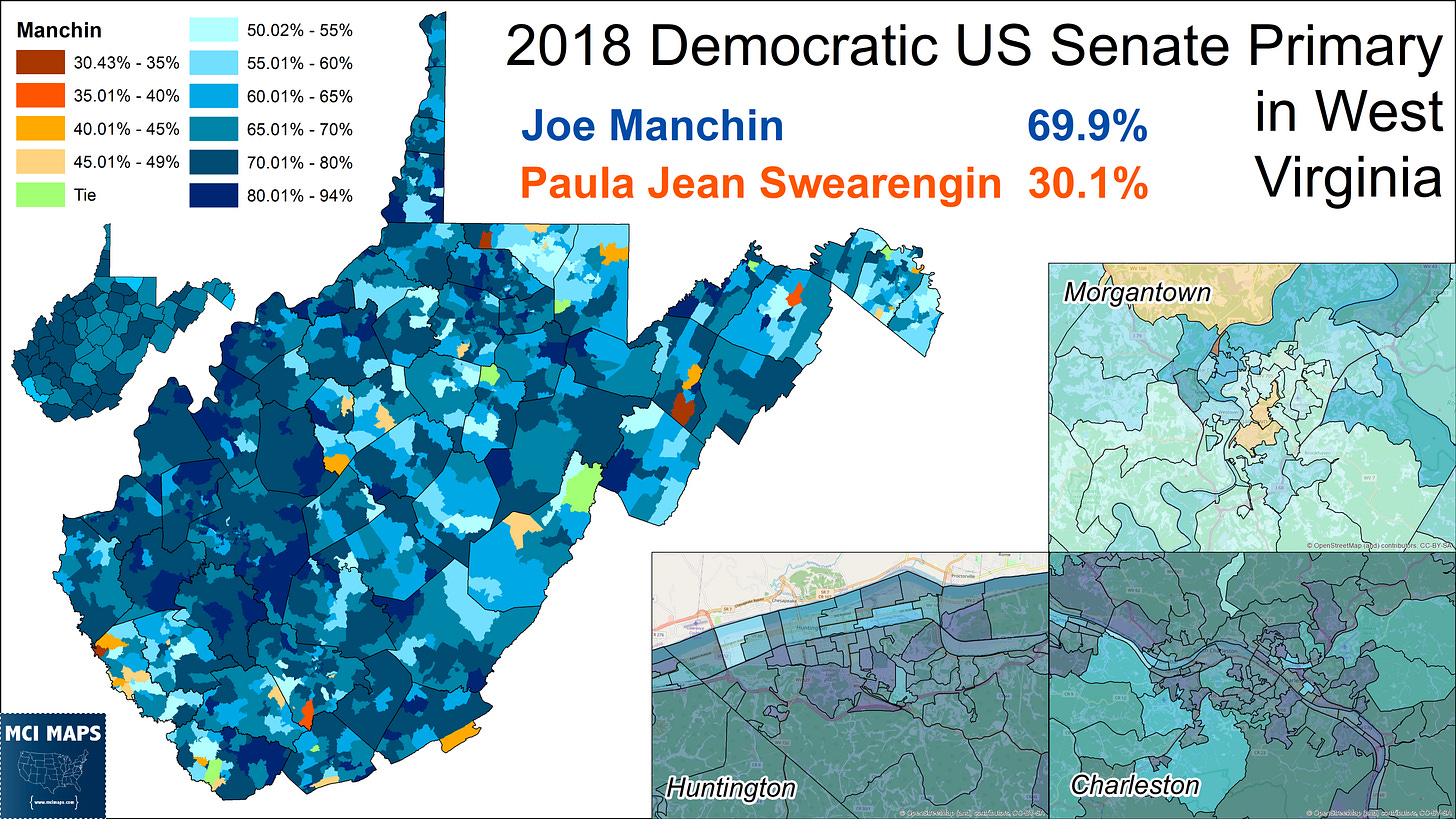Issue #178: Predicting Primary Protest Votes in the West Virginia Coal Fields
The Coal Democrats vs the National Party
Today, May 14th, West Virginia voters will be going to the polls for a long list of primary contests. In addition to voting in the Presidential Primaries, which are mere formalities now that Biden and Trump have secured their nominations, voters will be casting ballots for Governor, Senate, legislature, and local primary contests.
If you’ve been reading my stuff for awhile, you will know this means one thing, I have another excuse to write about protest votes from the coal fields. Expect to see massive anti-Biden primary votes coming out of the state. However, unlike in NYC, or Dearborn, or college towns, these will not be protests from the left, but rather from the right.
History of Protest Votes
Conservative protest votes are a common occurrence in modern Democratic primaries in West Virginia. They are a result of the state’s closed primaries and a large population of conservatives registered with the Democratic party. I have written about conservative coal Democrats in West Virginia multiple times.
The West Virginia protest vote gained national attention in 2012 with Obama’s re-election. That year, the President faced no major primary threat, only facing off with perennial candidates with little to no name-ID. In 2012, however, Obama was dragged under 60% of the vote by candidate Keith Judd, a man serving a prison sentence at the time.
Judd was strongest in the coal fields of West Virginia. However, he was not some prominent local official, he was just a guy who filed to run on the ballot. His share of the vote was entirely revolved around anti-Obama sentiment. These voters, conservative socially and very defensive of the coal industry, were moving further away from the national Democratic party.
At the time in 2012, West Virginia remained heavily Democratic in registration and still saw Democrats control many state and legislative posts. However, the trend for President had rapidly been moving to the GOP. Starting with 2000, the state would vote to the right of the nation and rapidly increase that right-wing slide through 2020.
Through the 1990s, the state’s conservative social stance were balanced by union jobs in the coal industry that kept the state in a moderately pro-worker, pro-labor posture. However, the decline of coal jobs, and the crushing of unions, led to increased unemployment, bitterness, and desires for scapegoats. The economic downturn in West Virginia is similar to the situation in Kentucky’s goal fields, something I discussed in this piece from last year.
The state, now full of voters angry at national environmental policies and unwilling to back progressive social issues like abortion or LGBT rights, led to Donald Trump winning 69% of the state in 2020.
Despite all of this, registration in West Virginia only flipped to the GOP shortly AFTER the 2020 election. Just as voters went to the polls that November, registration was basically tied. Of course, that was far below the massive Democratic advantage that existed in the 2012 primary that saw Judd do so well.
If you look at that registration graph and compare it with the Presidential results, you will see that there were clearly alot of registered Democrats voting Republican for President. These voters would also ticket-split on Congressional races, legislative seats, and local offices. However, these were very much conservative Democrats. They were showing up to vote for the local legislator or sheriff, not one of those “national sell-out” Democrats.
With the 2024 primary before us, I wanted to take a look back at the 2020 primaries and where the protest votes were highest; hence where we should be watching out for tonight.
The 2020 Democratic Primary
By the time the West Virginia Primary came around in May of 2020, Biden had already secured the Democratic nomination; with Sanders dropping out in April and given Biden his support. However, while the contest was a mere formality, I was watching to see what the non-Biden vote would like.
In the contest, Biden took 65% of the primary, which was lower than many other uncontested primaries from that time. Sanders only took 12%, not the main source of the non-Biden votes. Meanwhile, David Lee Rice, another of these perennial candidates, took 8%. Not only that, Rice outpaced Sanders across many of the coal fields and other rural counties.
Rice topped over 20% in several of the counties most synonymous with the coal fields, like Logan, Wyoming, McDowell, and Mingo. I also combined Rice’s vote share with several of the other dropped-out candidates like Yang or Bennett (people with no residual lefty support unlike an Elizabeth Warren), for a full 12% “protest” vote.
The combined protest votes took up 30% in Mingo County, which is the epicenter of coal protest votes from conservative democrats. However, this was in fact NOT the biggest protest. For that, we need to look at ballots not cast at all.
Blank Ballots and Turnout
While the vote for non-Biden and non-Sanders candidates was heavy in the Democratic primary, there was one vote even higher - people just leaving the ballot blank. In fact, 14% of the Democrats voting that day, aka people who showed up to vote on some race, just left President blank. If ‘blank’ was a candidate, it would have won three counties!
If we consider blank ballots a candidate, they performed strongest in the same rural areas we see previous protest votes; strongest of course in the coal fields. These blank ballots won far more precincts than the handful that either Sanders and Rice did.
It may seem crazy to some of you that so many voters would leave their ballots blank. The biggest reason is these conservative democrats were showing up for other contests. These blank ballots are folks who may have come out specifically because their local sheriff had a primary or they cared about the congressional races. In addition, West Virginia had Gubernatorial and US Senate Democratic primaries to vote on. Those races both saw more ballots cast than the Presidential contest.
While 14% of Democrats voting left their Presidential contest blank, the same was only true for 3% of Republicans (even as Trump had no major opponents). The blank ballots meant that in terms of votes cast in either the DEM or GOP Presidential primary, the Republicans led by 7% despite the fact that total votes cast by primary ballot (whether you voted every race or just one) showed a near tie. Nearly as many Democratic Primary ballots were passed out as Republican ballots.
The final piece of the puzzle is who bothered to show up at all.
That day, Republican turnout was 50% vs just 43% for Democrats. The GOP got a higher percent of their voters out across the state in all but a few counties, several of which show better long-term Democratic opportunities (namely Jefferson, Monongalia, and Kanawha). Meanwhile in the southern coal fields, Democratic turnout was under 35%.
So in places like McDowell or Mingo, fewer than half of registered Democrats showed up, and a plurality of those that did left the Presidential contest blank. These are the definition of “democrats in name only.”
The “Two Protests” to Watch
Like 2020, West Virginia will be holding primaries for US Senate, Governor, Congress, and a slew of local and regional races. I’ll be covering those and have discussed them more on my twitter feed (I’m out of room in this post).
There is one final item to watch in West Virginia, and that will be the potential for a lefty protest vote. It will be small and isolated, but worth watching. The best example of this was seen in 2018 when Joe Manchin was challenged by Paula Jean Swearengin. The Swearengin primary came from his left, with Manchin taking heat for his conservative voting record. However, in the primary contest, which saw Manchin secure 70% of the vote, Swearengin had a good deal of support from conservative coal Democrats.
Swearengin’s positions were to the left of Manchin, but like Sanders did in 2016 (read my review of that race), she took a great deal of support from conservatives who were just looking to “punish” the establishment. Manchin was already by that point the lone Democrat who could win the state, but he still had conservative coal Democrats angry with him for ever backing the national party. As a result, he underperformed in places like Mingo. At the same time, however, Swearengin did well in Morgantown, the home of West Virginia University. THIS is where to watch for anti-Biden protest votes. I venture the Biden protest will be similar to 2018, with a combination of conservative protests in the coal fields and liberal protests in Monongalia County.
Rest assured I will be obsessively over-analyzing the results once they come in. And no it has no real prediction value for November anywhere. Hey if you want to read more about Democratic primaries in deep red states, check out my coverage of conservative protests votes in the Louisiana primary from just two months ago!












